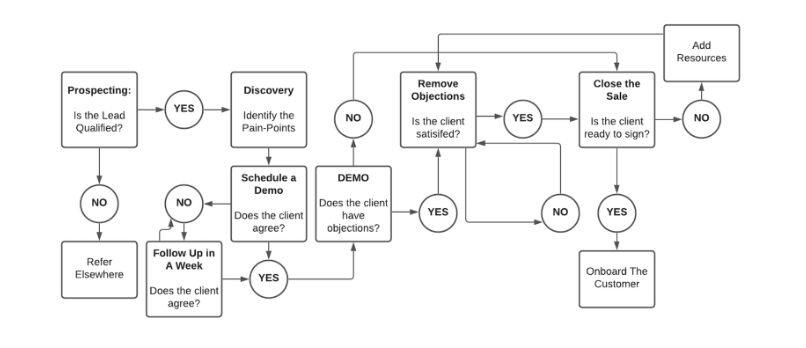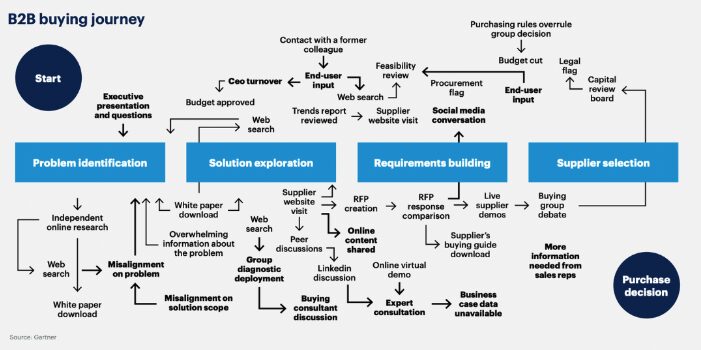In life, it’s all about the journey.
(We know this is a little cheesy, but just go with it.)
Well, this just so happens to be the case in B2B sales as well.
Because let’s face it, buyers don’t just become paying customers overnight.
So, it’s your job as a sales pro to guide prospects on the journey that is the sales process and make it as simple as possible for them to get from point A (being an early-stage lead) to point B (becoming a loyal customer).
Join us as we break down everything you need to know about creating a highly converting sales process.
What is a sales process?
But first, let’s kick things off with some basics.
A sales process is the series of steps that a sales team follows to take leads and turn them into paying customers.
It’s essential to have a strong sales process so your team will have a framework to guide them and help make sure they are consistently closing deals.
Why is a sales process important?
That’s all fine and good.
But why is a sales process important?
Did you read our minds or something? This is the exact question that we were hoping you’d ask!
When done right, a sales process is like an outline that helps guide your team as they try to turn early-stage leads into your new customers.
Plus, having this “guide” helps newer reps learn what they need to do at each stage of the sales cycle and learn the best practices.
Without this framework, it would be much harder for reps to focus their efforts in the right place.
Sales process steps
At this point, we’ve convinced you (or at least we tried) that the sales process is essential and that you need to find ways to make it as efficient as possible.
Well, let’s start off by saying that you just made this content writer’s day!
But we wouldn’t be doing our jobs if we didn’t tell you to take it one step at a time. And the next step just happens to be to go over the steps involved in a typical sales process.
Usually, these six stages are involved:
1. Prospecting
It all starts with a lead.
But contrary to what you might have heard, leads don’t grow on trees.
(We were also shocked when we found this out.)
So, you’ll need to go out and find prospects to move through the sales process. And this is what we like to call prospecting.
When it comes to prospecting, you first need to understand your target market. Think about who you want to talk to, what their potential needs are, and how you can help them.
Then, you’ll want to create your list of leads by searching sites like LinkedIn, Crunchbase, or Zoominfo. Some GTM teams also purchase a database to look for early-stage leads. Once you’ve got your list of prospects, it’s time to reach out to them via call, email, or social media.
BTW, if you use an interactive product demo software (like Walnut), you can even include a product demo with your outreach emails to engage prospects and better qualify your leads.
2. Discovery
You’ve collected a solid list of leads.
But unfortunately, not all leads are created equal.
So, the next step in the sales process is to qualify your leads, or to determine whether or not they would be a good fit for your product.
Because why waste both the prospect’s time and yours if in all likelihood, they are never going to pull the trigger?
To qualify leads, sales teams will typically have a discovery call and ask questions like:
1. What problem are you trying to solve?
2. What is your role in the company?
3. Are you looking into other solutions?
4. Is solving this pain a priority for your team and company?
5. What budget do you have for a solution?
All of these questions will help you determine if it’s worth moving the prospect forward in the sales process.
3. Demo
You’ve realized that your product could have a life-altering impact on your prospect.
And now, this is the moment of truth. It’s time to break out a killer product demo and show what your product can do.
In our humble opinions, the product demo is the most important part of the sales process.
Because when it goes according to plan, it can show the prospect the benefits of your SaaS product and the value it can bring them. And when it goes wrong, it can send your deal to “let’s revisit this next quarter” territory.
So, not only does your demo need to be engaging, but it also needs to be personalized so the prospect can visualize how your product will solve their unique pain points.
4. Objection handling
Even though you just delivered a kick-ass demo, a prospect still might bring up an issue or two with your product or give a reason that implies they’re not interested in buying.
But this doesn’t mean that your deal is dead. There are ways to successfully handle these objections and convince the prospect to continue moving forward.
Some helpful techniques for objection handling include validating their concerns, speaking with confidence, showing them what you’re talking about, utilizing data and social proof, and planning the next steps.
Just remember that there is a difference between objection handling and negotiating SaaS deals, which you should only use after the prospect has decided they want your product.
5. Closing
Closing time, time for you to go out to the places you will be from.
Sorry, we just love that song.
But ok, let’s get back on track.
Once the prospect has decided they are ready to take the plunge, you’ll need to complete a few different activities that center around getting them to sign on the dotted line.
This can involve sending a quote or proposal, negotiating, and getting the decision-makers’ buy-in.
To negotiate, we recommend that you pay close attention to your profit margin, keep up with the competition, and make sure you are negotiating with the decision-maker.
6. Onboarding and retention
Closing a deal ≠ Your work is done.
Because when it all comes down to it, it doesn’t matter that you closed a deal if the prospect ultimately jumps ship.
To help drive product adoption, you’ll want to make sure you have a strong customer onboarding program in place, you make it easy for customers to get support or get in touch with your team, and consistently monitor customer satisfaction so you can make sure your customers stay with your company for the long run.
Creating a sales process flowchart
Now that we understand all of the steps in the sales process, we need a way to visualize the process as a whole.
A B2B SaaS sales process flowchart is a graphical representation of the different stages of the sales process. This offers a way for you to map out your sales process and make it easier to understand where it needs to be more efficient.

Here are just some of the benefits of using a sales process flowchart:
1. Provide your sales team with a system that they can follow to close sales like they would with a road map.
2. Create consistency for both sales staff and clients on the following steps to follow during the sales processes.
3. Break up the sales process into steps to make it easier to identify problems and make adjustments.
4. Control and optimize the process.
When done right, your sales process flowchart will ensure your sales team always knows what to say and do during each part of the sales process.
Best practices for improving your sales process
There’s always room for improvement. And this is especially true when it comes to your sales process.
That’s why you and your team will want to follow the sales process best practices.
Not only will doing so improve your sales process, but it will also make sure you and your team stay aligned by providing standardized guidelines to follow during the sales journey.
Here are a few of the best practices you and your team should follow:
1. Analyze your existing sales process
No matter how long you’ve been in the sales game, you can always make adjustments to improve the efficiency of your sales process.
So, it’s a good idea to take a big picture view of your overall sales process to determine what’s working (and what isn’t). This will help you understand where to make improvements going forward.
We recommend evaluating how your reps work throughout the sales process, considering on average how much time the entire process took, as well as how much time passed between each step.
On top of this, it’s a good idea to look at the specific pain points customers that purchased your product had.
2. Outline the buyer’s journey
Next, you’ll want to outline the steps your target audience will take during the buyer journey.
This will enable you to view your sales process from the perspective of your prospects. Specifically, you’ll want to look at the interactions they have with your reps and what specific pain points each buyer persona wants to address.
Then, you’ll be able to tailor your sales process based on this information to ensure buyers have everything they need at every point of the process.
3. Define the process
Your sales team also needs to understand what it will take to move a prospect from one step to the next.
This involves considering if there are any specific actions the reps or prospects need to take before the process can move forward.
After a demo, for example, a rep may need to address any objections the prospect had or send the prospect additional materials to move the process to the closing stage.
4. Track results
You and your team have invested in making the sales process as efficient as possible.
First of all, that’s what we love to hear!
But how can you figure out if all that hard work is paying off?
We recommend monitoring the average amount of time it takes for prospects to move to each step, what percentage of prospects sign on the dotted line after a demo, the percentage of buyers that book a demo after a discovery call, and the churn rate.
How technology is used in the sales process
The year is 2023.
There’s tech for just about anything: devices to automatically feed your pets, a smart belt, or even a selfie toaster.
(We aren’t even kidding about that last one.)
So, naturally, there’s tech available to help streamline every stage of the sales process.
While every team’s sales tech stack will look different, typically go-to-market (GTM) teams will use customer relationship management (CRM) software, outreach tools, email optimization software, communication software, scheduling tools, and demo platforms.
When it comes to that last one, you’ll want to find a solution that allows you to quickly deliver interactive and personalized demos. Because like we said, the product demo is what can move prospects along to the closing stage or send them running for the hills.
Luckily, we know of a platform (have you met Walnut?) that can help you nail this critical moment in the sales process.
But more on that a bit later on.
Common sales process mistakes
Developing a highly converting sales process isn’t easy.
But learning from common sales process mistakes will help make it easier to create a sales process that fits both buyers’ and your team’s needs.
Here are the most common mistakes sales pros make when it comes to the sales process:
1. Not defining clear steps—You’ll want to make sure that you establish clear steps and that your team understands what needs to happen for prospects to move from one step to the next.
2. Never refining your sales process—Like we said before, there’s always room for improvement. So, make sure you continue to analyze your sales process to uncover any major issues or red flags with regards to your process.
3. Not including marketing—Teamwork makes the dream work! So, you’ll want to make sure your sales team aligns with marketing so they have all the information they need to better assist during each part of the sales process.
4. Not measuring KPIs—If you don’t track key metrics, how can you tell if your sales process is really effective? That’s why it’s critical to track KPIs to understand what’s going well (and what isn’t).
5. Overcomplicating the sales process—Often, the process of buying SaaS is super complicated. Just look at Gartner’s depiction of the B2B buying journey. Scary right?

That’s why it’s your job as sellers to make the sales process as simple as possible for buyers to improve the sales experience.
Using product demos to enhance your sales process
You can think of the sales process as being like the journey the prospect will take with your sales team. And your job is to make it as easy as possible for them to reach the destination: a purchase of your product.
While each stage is important in getting a prospect to take the plunge, one part of the sales process has the power to make or break your deal: the product demo.
That’s why you need to do everything you can to make sure the demo experience is engaging, interactive, and personalized to each and every prospect your team pitches to.
And one way to do this is by using a demo platform. (Does the name Walnut ring a bell?) These kinds of tools make it easy to quickly showcase your product’s unique value proposition and convince prospects they can’t live without your solution.
Plus, if you use a demo platform (like Walnut), you can embed a demo on your website or send demos in your outreach emails so prospects can see the product at any point in the sales process.
The bottom line is that by using a demo platform (Walnut?) to create interactive and personalized product demos, you’ll give your team everything they need to build a sales process that converts.
The end. (Walnut.)
FAQs
1. What is the difference between a sales process and sales methodology?
To put it simply, when we talk about a sales process, we are referring to the specific steps that a sales team follows that lead buyers to take specific actions. This includes all of the activities that happen from the prospecting stage to closing.
Meanwhile, a sales methodology is a set of principles or philosophies that salespeople can use to improve their sales process and make it more efficient.
2. What are the 6 steps of the sales process?
The six steps of the sales process are prospecting, discovery, demo, objection handling, closing, and onboarding/retention.
3. What is the most important step in the sales process?
You have a qualified lead.
Now, it’s time for the most important step in the sales process: the product demo!
Because this is where you show the prospect why your product can solve all of their unique pain points.
So, what’s holding you back? Get started using Walnut by pushing the “Get Started” button at the top of your screen.





